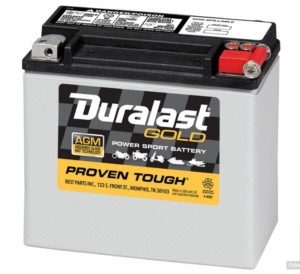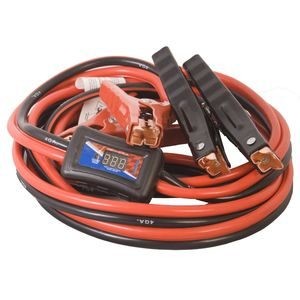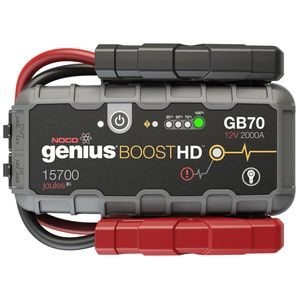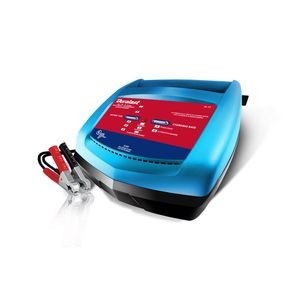How To Jump My Car Without Another Car? It’s a common question for drivers facing a dead battery situation. CARS.EDU.VN provides you with detailed knowledge and alternative methods like portable jump starters and battery chargers to confidently revive your car’s power. Master solo jump-starting, understand battery health, and ensure automotive safety with our comprehensive guide, and discover the benefits of vehicle maintenance for optimal car performance.
1. Understanding Car Battery Basics
The car battery, a rechargeable energy storage device, plays a vital role in powering your vehicle’s electrical systems. Primarily, it’s responsible for initiating the engine start-up process. Once the engine is running, the alternator typically takes over, supplying power to the car’s electrical components. However, the battery can become depleted due to various reasons, such as a malfunctioning alternator or an electrical drain caused by a faulty component or accidentally leaving lights on.
Recognizing the symptoms of a failing battery is crucial for proactive car maintenance. These signs may include a sluggish engine crank during start-up, a battery warning light illuminating on the dashboard, and sluggish performance of electrical components like lights or power windows. If your car exhibits these symptoms, it’s a strong indicator of a weakened or dead battery.
Key Functions of a Car Battery:
- Engine Starting: Provides the initial power to start the engine.
- Electrical System Support: Supplements the alternator in powering electrical components.
- Voltage Stabilization: Helps regulate voltage to protect sensitive electronics.
- Emergency Power: Offers a reserve of power if the alternator fails.
2. Essential Safety Precautions for Solo Jump Starting
Prioritizing safety is paramount when handling car batteries, especially when performing a jump start alone. Car batteries contain corrosive acid and can produce explosive gases. Always wear safety glasses or goggles and gloves to protect your eyes and skin from potential hazards.
- Eye Protection: Wear safety glasses or goggles to prevent battery acid from splashing into your eyes.
- Hand Protection: Use gloves made of acid-resistant material to protect your hands from burns.
- Ventilation: Ensure the area is well-ventilated to prevent the build-up of explosive gases.
- No Smoking: Avoid smoking or open flames near the battery.
- Battery Condition: Inspect the battery for cracks, leaks, or bulges, which indicate a compromised battery that shouldn’t be jump-started.
In case of battery acid leaks, have a readily available battery acid neutralizer spray or a mixture of baking soda and water on hand to neutralize the acid. Additionally, keeping a fire extinguisher nearby can be a smart safety precaution.
When to Avoid Jump Starting:
- Damaged Battery: Do not jump-start a battery that is cracked, leaking, or bulging.
- Freezing Temperatures: Avoid jump-starting a frozen battery, as it may explode.
- Unfamiliar with Procedure: If you are unsure about the jump-starting procedure, seek professional assistance.
3. Step-by-Step Guide: Jump Starting Your Car Without Assistance
Mastering the technique of jump-starting a car on your own is a valuable skill, particularly for frequent solo drivers. These straightforward steps will guide you through the process, irrespective of the chosen method.
3.1. Locating and Accessing the Battery
First, locate the car battery, which is typically positioned under the hood. In some models, it might be in the trunk or under the rear seat. Consult your car’s manual for the exact location if you’re unsure.
Tips for Locating Your Car Battery:
- Check the Owner’s Manual: The owner’s manual provides detailed information about the battery’s location and any specific jump-starting instructions for your vehicle.
- Under the Hood: In most cars, the battery is located in the engine compartment, typically near the front of the vehicle.
- In the Trunk: Some cars have the battery located in the trunk, often under a panel or behind a trim piece.
- Under the Rear Seat: In rare cases, the battery may be located under the rear seat.
3.2. Using a Portable Jump Starter
A portable jump starter is a compact, self-contained device that can provide enough power to start your car without needing another vehicle. Here’s how to use one:
- Power Off: Ensure your car’s ignition and all electrical systems are switched off.
- Connect Clamps: Attach the red clamp to the positive terminal of your car battery and the black clamp to a clean, unpainted metal surface away from the battery.
- Power On the Jump Starter: Turn on the jump starter and follow the manufacturer’s instructions.
- Start Your Engine: Attempt to start your engine as you normally would.
- Disconnect and Recharge: Once your car is running, disconnect the clamps in reverse order and recharge the jump starter.
Benefits of Using a Portable Jump Starter:
- Convenience: No need for another vehicle or assistance.
- Portability: Easy to store in your car for emergencies.
- Safety: Built-in safety features to prevent damage and injury.
- Versatility: Many models include USB ports for charging electronic devices.
3.3. Using a Battery Charger
A battery charger can be used to revive a dead battery, but it requires more time than a jump starter. Follow these steps:
- Preparation: Park your car in a well-ventilated area and turn off the ignition.
- Connect the Charger: Connect the red (positive) clamp to the positive terminal of the battery and the black (negative) clamp to a metal part of the car’s chassis, away from the battery.
- Charging: Plug in the battery charger and select the appropriate charging setting (usually a slow charge for a deeply discharged battery).
- Monitor the Charge: Let the battery charge for several hours or overnight, monitoring the charger’s progress.
- Disconnect and Test: Once the battery is charged, disconnect the charger in reverse order and try starting your car.
Choosing the Right Battery Charger:
- Type of Battery: Select a charger that is compatible with your car’s battery type (e.g., lead-acid, AGM, gel).
- Charging Rate: Choose a charger with a low charging rate (2-10 amps) for optimal battery health.
- Automatic Shut-Off: Look for a charger with an automatic shut-off feature to prevent overcharging.
Safety Tips for Using Battery Chargers:
- Ventilation: Ensure the area is well-ventilated to prevent the build-up of explosive gases.
- Proper Connections: Double-check the connections to ensure they are secure and correct.
- Monitor the Charging Process: Keep an eye on the charger and battery during the charging process.
- Avoid Overcharging: Do not overcharge the battery, as it can damage the battery’s cells.
3.4. Disconnecting the Cables
Once the car starts, carefully disconnect the cables in the reverse order that you connected them. This helps prevent sparks and potential damage to your vehicle’s electrical system.
- Remove the black cable from the ground connection (engine block or chassis).
- Remove the black cable from the negative terminal of the working battery.
- Remove the red cable from the positive terminal of the working battery.
- Remove the red cable from the positive terminal of the dead battery.
4. Other Options to Consider
4.1. Calling for Roadside Assistance
If you’re uncomfortable jump-starting your car yourself, or if you don’t have the necessary equipment, consider calling for roadside assistance. Many insurance companies and auto clubs offer roadside assistance services that can help you jump-start your car or provide other assistance.
Benefits of Calling Roadside Assistance:
- Professional Help: Experienced technicians can safely jump-start your car or diagnose other issues.
- Convenience: No need to purchase or carry jump-starting equipment.
- Safety: Avoid the risks associated with jump-starting a car yourself.
- Additional Services: Roadside assistance may include towing, fuel delivery, and other services.
4.2. Using a Mobile Mechanic Service
Mobile mechanic services are becoming increasingly popular. These services send a mechanic to your location to perform repairs and maintenance, including jump-starts. This can be a convenient option if you’re stranded at home or work.
Benefits of Using a Mobile Mechanic Service:
- Convenience: The mechanic comes to you, saving you time and hassle.
- On-Site Repairs: Many repairs can be performed on-site, eliminating the need for towing.
- Personalized Service: You can discuss your car’s issues directly with the mechanic.
- Competitive Pricing: Mobile mechanic services are often more affordable than traditional repair shops.
5. Alternative Jump-Starting Methods Without Another Car
If you find yourself without access to another vehicle, there are several alternative methods for jump-starting your car battery. Always review the product instructions before use.
5.1. Push Start (Manual Transmission)
If your car has a manual transmission, you might be able to push-start it. This method requires a bit of physical effort and a slight downhill slope:
- Get Help: Enlist the help of a few friends or passersby to push the car.
- Get In: Put the key in the ignition and turn it to the “on” position.
- Pushing: Have your helpers start pushing the car, and once it reaches a speed of about 5-10 mph, depress the clutch and shift into second gear.
- Pop the Clutch: Quickly release the clutch while giving it some gas.
- Start the Engine: If successful, the engine should start. If not, try again.
Tips for Push Starting:
- Choose a Safe Location: Select a safe location with a slight downhill slope and minimal traffic.
- Communicate Clearly: Communicate clearly with your helpers to ensure everyone knows what to do.
- Be Prepared to Steer: Be prepared to steer the car once the engine starts.
5.2. Solar Battery Charger
A solar battery charger is a device that uses solar energy to charge your car battery. This can be a useful option if you’re stranded in a sunny location.
How to Use a Solar Battery Charger:
- Position the Charger: Place the solar battery charger in a location where it will receive direct sunlight.
- Connect the Charger: Connect the charger to your car battery’s terminals, following the manufacturer’s instructions.
- Let It Charge: Allow the charger to charge the battery for several hours or even a full day, depending on the charger’s output and the battery’s condition.
- Try Starting the Car: Once the battery has charged sufficiently, try starting the car.
Benefits of Using a Solar Battery Charger:
- Eco-Friendly: Uses renewable solar energy to charge the battery.
- Portable: Easy to carry and store in your car.
- Convenient: Can be used in remote locations where other charging options are not available.
- Maintenance-Free: Requires minimal maintenance.
5.3. Wind Turbine Charger
A wind turbine charger is a device that uses wind energy to charge your car battery. This can be a useful option if you’re stranded in a windy location.
How to Use a Wind Turbine Charger:
- Position the Turbine: Place the wind turbine charger in a location where it will receive a strong, consistent wind.
- Connect the Charger: Connect the charger to your car battery’s terminals, following the manufacturer’s instructions.
- Let It Charge: Allow the charger to charge the battery for several hours or even a full day, depending on the turbine’s output and the battery’s condition.
- Try Starting the Car: Once the battery has charged sufficiently, try starting the car.
Benefits of Using a Wind Turbine Charger:
- Eco-Friendly: Uses renewable wind energy to charge the battery.
- Portable: Easy to carry and store in your car.
- Convenient: Can be used in remote locations where other charging options are not available.
- Maintenance-Free: Requires minimal maintenance.
6. Understanding Potential Causes of a Dead Battery
Identifying the root cause of a dead battery is crucial to prevent future occurrences. Here are some common culprits:
- Leaving Lights On: Accidentally leaving headlights, interior lights, or accessories on can drain the battery.
- Short Trips: Frequent short trips may not allow the alternator enough time to fully recharge the battery.
- Old Battery: Car batteries have a limited lifespan, typically 3-5 years.
- Parasitic Drain: Electrical components that continue to draw power when the car is off can drain the battery.
- Extreme Temperatures: Both hot and cold temperatures can negatively impact battery performance.
- Faulty Alternator: A malfunctioning alternator may not properly charge the battery while the engine is running.
Tips for Preventing a Dead Battery:
- Turn Off Lights: Always ensure that all lights and accessories are turned off when you exit the car.
- Regular Driving: Take your car for longer drives periodically to allow the alternator to fully charge the battery.
- Battery Maintenance: Have your battery tested regularly and replace it when necessary.
- Check for Parasitic Drain: If you suspect a parasitic drain, have a mechanic diagnose and repair the issue.
- Use a Battery Tender: If you store your car for extended periods, use a battery tender to keep the battery charged.
7. Routine Maintenance for Optimal Battery Life
Extending the lifespan of your car battery requires consistent maintenance practices. The following measures will help keep your battery in top condition:
- Regular Inspections: Periodically inspect the battery terminals for corrosion and clean them with a wire brush and battery terminal cleaner.
- Secure Connections: Ensure that the battery cables are securely connected to the terminals to prevent voltage drops.
- Load Testing: Have your battery load-tested by a professional to assess its overall health and ability to hold a charge.
- Cleaning: Keep the battery case clean and free of dirt and debris, which can contribute to parasitic drain.
By following these maintenance tips, you can maximize the lifespan of your car battery and avoid unexpected breakdowns.
8. Troubleshooting Common Jump-Starting Issues
Even with careful planning, jump-starting a car can sometimes present challenges. Here’s how to address some common issues:
- Car Won’t Start: If the car still won’t start after jump-starting, ensure that the jumper cables are properly connected and that the battery has had enough time to charge.
- Sparks: If you see sparks while connecting the jumper cables, double-check the polarity of the connections and ensure that the cables are securely attached.
- No Power: If there is no power at all when you turn the key, the battery may be completely dead or there may be a problem with the car’s electrical system.
- Engine Cranks Slowly: If the engine cranks slowly but doesn’t start, the battery may be weak or there may be a problem with the starter motor.
When to Seek Professional Help:
- Repeated Jump-Starting: If you have to jump-start your car frequently, there may be an underlying issue that needs to be addressed by a mechanic.
- Unfamiliar with Procedure: If you are uncomfortable jump-starting your car yourself, it is best to seek professional assistance.
- Damaged Battery: If your battery is damaged, leaking, or bulging, do not attempt to jump-start it.
9. Understanding Battery Types
There are several types of car batteries available, each with its own advantages and disadvantages. Here are some common types:
- Lead-Acid Batteries: These are the most common type of car battery and are relatively inexpensive.
- AGM (Absorbent Glass Mat) Batteries: These batteries are more durable and have a longer lifespan than lead-acid batteries.
- Gel Batteries: These batteries are similar to AGM batteries but use a gel electrolyte instead of a liquid.
- Lithium-Ion Batteries: These batteries are lightweight and have a high energy density, but they are also more expensive than other types of batteries.
Choosing the Right Battery Type:
- Vehicle Requirements: Check your car’s owner’s manual to determine the recommended battery type for your vehicle.
- Budget: Consider your budget when choosing a battery type, as some types are more expensive than others.
- Performance: If you need a battery that can handle demanding electrical loads, consider an AGM or gel battery.
10. Future Automotive Battery Technology Trends
The future of automotive battery technology is rapidly evolving, with advancements in several areas:
- Solid-State Batteries: These batteries offer higher energy density, improved safety, and faster charging times compared to traditional lithium-ion batteries.
- Wireless Charging: Wireless charging technology is becoming increasingly popular for electric vehicles, allowing drivers to charge their cars without plugging in.
- Battery Management Systems (BMS): Advanced BMS systems are being developed to optimize battery performance, extend battery life, and improve safety.
- Recycling Technologies: New recycling technologies are being developed to recover valuable materials from used batteries, reducing waste and environmental impact.
Impact of These Trends:
- Longer Driving Ranges: Advanced battery technologies will enable electric vehicles to travel longer distances on a single charge.
- Faster Charging Times: Faster charging technologies will reduce the time it takes to recharge electric vehicles.
- Improved Battery Life: Advanced battery management systems will extend the lifespan of car batteries.
- Reduced Environmental Impact: New recycling technologies will reduce the environmental impact of car batteries.
11. CARS.EDU.VN: Your Partner in Automotive Education and Assistance
At CARS.EDU.VN, we understand the challenges car owners face, from unexpected breakdowns to the need for reliable maintenance information. Our goal is to provide you with the knowledge and resources you need to confidently care for your vehicle.
How CARS.EDU.VN Can Help You:
- Expert Advice: Access expert advice and guidance on all aspects of car maintenance and repair.
- Step-by-Step Guides: Follow our step-by-step guides to perform common maintenance tasks yourself.
- Product Reviews: Read our unbiased product reviews to make informed purchasing decisions.
- Troubleshooting Tips: Find solutions to common car problems with our troubleshooting tips.
- Local Service Directory: Locate reputable mechanics and service providers in your area.
We are committed to providing you with the most up-to-date and accurate information to keep your car running smoothly.
CARS.EDU.VN Contact Information:
- Address: 456 Auto Drive, Anytown, CA 90210, United States
- WhatsApp: +1 555-123-4567
- Website: CARS.EDU.VN
12. FAQ: Jump Starting Your Car
Here are some frequently asked questions about jump-starting your car:
12.1. Can I jump-start my car without another vehicle?
Yes, you can use a portable jump starter or a battery charger.
12.2. What safety precautions should I take when jump-starting my car alone?
Wear safety gloves and goggles and follow proper procedures to avoid sparks and potential battery acid exposure.
12.3. Are portable jump starters effective for all types of vehicles?
Portable jump starters come in various sizes and have different power ratings. Choose one that is powerful enough for your vehicle’s engine size.
12.4. Can a completely dead battery be revived without professional help?
It’s possible to revive a completely dead battery with a high-quality battery charger, but if you’re not successful, you may need a professional to determine if it’s a charging problem or if the battery needs replacement.
12.5. Are there any specific conditions where solo jump-starting is not recommended?
If your battery is located in a hard-to-reach or dangerous location, it’s best to have someone help you.
12.6. How long does it take to jump-start a car?
Typically, it takes about 5-10 minutes to jump-start a car using jumper cables or a portable jump starter.
12.7. Can I damage my car by jump-starting it incorrectly?
Yes, improper jump-starting can damage your car’s electrical system, so it’s essential to follow the correct procedures.
12.8. What should I do if my car won’t start after jump-starting it?
If your car won’t start after jump-starting, there may be an underlying issue that needs to be addressed by a mechanic.
12.9. How often should I replace my car battery?
Car batteries typically last for 3-5 years, depending on the type of battery and the driving conditions.
12.10. Where can I find more information about car batteries and jump-starting?
You can find more information about car batteries and jump-starting on CARS.EDU.VN.
Here’s a table summarizing key information for quick reference:
| Topic | Key Points |
|---|---|
| Jump Starting | Use portable jump starter or battery charger if no other car is available. |
| Safety Precautions | Wear gloves, goggles, and ensure proper ventilation. |
| Battery Maintenance | Regularly inspect and clean battery terminals. |
| Potential Issues | Check cable connections and battery condition if jump-starting fails. |
| Battery Types | Lead-acid, AGM, gel, and lithium-ion options available. Choose according to vehicle needs and budget. |
| Future Battery Tech | Advancements in solid-state batteries, wireless charging, and BMS systems are expected. |
| CARS.EDU.VN | Offers expert advice, step-by-step guides, and a local service directory. |




CARS.EDU.VN is here to help. Are you struggling to find reliable car repair services or unsure how to maintain your vehicle properly? Visit cars.edu.vn today for expert guidance, detailed service information, and solutions to all your automotive needs.
